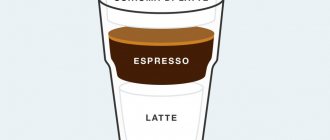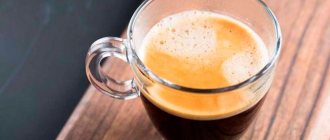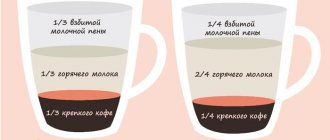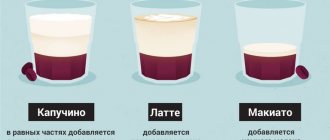January 10, 2013 Varieties and recipes
Latte (also known as latte macchiato) is a milk drink based on espresso coffee. It is prepared using foamed milk and consists of three layers: milk, coffee and milk foam. It has a delicate milky taste, served in a tall glass or Irish glass, with a foam spoon.
Latte macchiato was originally invented for children in order, on the one hand, to allow them to drink coffee on an equal basis with adults, and on the other, to rid the child’s body of excess caffeine. The drink is very popular in Central and Western Europe among all segments of the population.
What does a latte consist of?
In the world of coffee, the word Latte refers to a layered cocktail: espresso, milk and a small amount of milk foam.
Translated from Italian, the word latte means milk. This hot drink consists of espresso coffee and milk in a ratio of about 1:3 - three parts frothed milk to one part espresso.
The drink is served in a tall glass glass with a long ice cream scoop and straw and consists of three layers that do not mix with each other. The first layer is hot milk, the second is espresso coffee, the last, top layer is high foam whipped from milk. Espresso does not mix with the first milk layer due to its higher temperature and lower density than full-fat milk.
The easiest way to achieve the required “layering” is to pour the espresso into the drink last, passing it through a layer of foam.
Trends in Russian
We must not forget that the Russian language is a moving system that changes over time. Therefore, sometimes even philologists who are asked the question of which syllable is stressed on latte coffee, they claim that both options are acceptable. The emphasis on the last syllable in the name of the drink seems more natural and preferable to Russian speakers. Therefore, it cannot be ruled out that after some time the last vowel will become stressed and such a norm will become generally accepted.
Latte, which syllable is stressed? The stress in the word "latte" is on the last syllable. However, if you speak differently, it’s okay: over time, norms in the Russian language change, and at the moment both options are acceptable. Although, if we pay tribute to the origin of the drink, we should remember what it is called in its historical homeland.
How is the latte served?
Although latte is a coffee of Italian origin, its presentation and presentation around the world can be very different from the Italian original.
Latte is usually served in an Irish glass, on a saucer with a napkin (to hold the sometimes hot glass), in a special large cup (like for cappuccino, only larger - 300 ml) or in a tall glass with a straw.
Traditionally, latte is served in a special Irish glass. It has a handle, the glass of which must be heat-resistant for ease of feeding. The volume of the glass is about 250 milliliters.
Some establishments serve the so-called ghetto latte or bottled latte. This means that all the ingredients of the drink are served separately, and customers mix milk and espresso to their taste, adding cinnamon, chocolate, syrups or other seasonings if desired.
There are many layered coffee cocktails based on latte: hazelnut latte, iced latte, cinnamon latte, chocolate and whipped cream latte, ice cream latte. Any syrups intended for making coffee cocktails (except citrus, since it turns the milk sour) can also be safely added to the drink.
The combination of latte coffee and blackcurrant syrup is considered the most successful. You can also make an alcoholic cocktail - for example, an amaretto latte or a rum latte. A particularly refined latte is obtained by adding 10-15 ml of Baileys liqueur.
Italians prefer to drink latte, like other coffee drinks with milk, in the morning. Oddly enough, in Italy itself, latte is not as popular as in other European countries - Italians love strong black coffee too much. Americans drink lattes in huge doses; a serving of latte at Starbucks, for example, can reach a volume of 600 ml.
How to remember the correct accent
If you find it difficult to refuse the wrong accent at the end, you can keep a formula in your head to remember: “Latte is sweet.” Or come up with your own. Then language difficulties will not prevent you from enjoying the taste of a wonderful drink.
By the way, if you go to Italy and want to order a cup of aromatic latte there, the usual one word will not be enough. Instead of a coffee drink, they will bring you a glass of milk. When ordering in Italy, you should say, like the locals, caffè latte, then you will be understood correctly.
Classic latte recipe
- Prepare a standard shot of classic espresso;
- Whisk 150-170 ml of milk in a pitcher using steam. At the same time, latte foam should be more fluffy and airy than cappuccino foam;
- Pour the frothed milk into a glass, then slowly pour the espresso into it in a thin stream.
If the whole procedure is carried out carefully, the layers of coffee and milk will not mix and you will get a delicious layered coffee cocktail. It is sometimes also called latte macchiato (also pronounced latte macchiato, latte macchiato, etc.). If the frothed milk is at the right consistency and the espresso is at the right temperature, the layers should separate clearly. It is the clear separation of the three layers that is considered the first indicator of the quality of a latte macchiato. If you do not have enough experience or do not have professional utensils and accessories to separate layers of foam, milk and espresso, you can use a spoon.
How do you say it in Russian: it or he
Another question worries many lovers of this gourmet coffee: “What kind of noun is latte? What is the correct way to talk about this drink, he or it?” The gender of the word latte is also not entirely clear.
Authoritative dictionaries write that this word can be neuter or masculine, like the similar nouns “cappuccino” and “espresso”. Both usages will be correct. Both options will be equivalent, unlike the use of the noun coffee, which has only a masculine gender.
Differences between latte and cappuccino
In the modern world, it is difficult to find a person who has never tried a latte or cappuccino in his entire life. However, not everyone knows the difference between them. Also, many people make a mistake in the word “cappuccino”, believing that it contains double letters. At the same time, in the word “latte” the stress always remains on the first syllable.
The main difference between a cappuccino and a latte is, first of all, that the latter is not coffee. In fact, a latte is just a coffee drink; sometimes it is also called a cocktail. It may follow from this that the volume of coffee in a cappuccino is much larger than the entire drink. If you rely on the classic latte recipe that we described above, two servings of milk are required per serving of espresso (milk foam can also be used). For cappuccino, each ingredient has the same proportions.
Proportions of milk and espresso in cappuccino and latte.
Even their foams are different. Of course, milk foam in any case should have a uniform consistency and no air bubbles. But the significant difference is that thicker foam is used for cappuccino. When the foam does not fall off when sugar gets on it, this means that the drink is prepared correctly.
However, both drinks still have similarities. Namely, the method of their preparation. First, a portion of coffee is poured, then milk is added. It must first be heated to a certain temperature. Usually it is about sixty degrees.
The serving method also differs for each type of coffee. For cappuccino, cups of 180 milliliters are usually used, no more. With this volume you get a better balance between milk and espresso. To ensure that there is enough milk for the entire coffee, it is better to use cups with an expanded top.
For both latte and cappuccino, the same temperature is acceptable, no higher than seventy degrees. By adding frothed milk to the drink, you can use it to create various patterns on the surface. There is a special technique called latte art.
In conclusion, we can conclude that the similarities between the two types are only in the method of preparation. Everything else is completely different.
(2 likes)
Ukrainian Coffee Festival
Previous post
Americano
Next entry
Reason for error
In Russia, the stress in a word is often transferred to the last syllable. For what reasons? Everything is very simple: many believe that the word originally came to us from the French language, where the last syllable is always stressed. This error is very easy to explain. Many culinary borrowings came to us from France. However, it was different with coffee with milk or ice cream, although many believe that the drink was invented by French chefs. Now you know that this hypothesis is wrong, and you will not be mistaken when ordering your favorite coffee.
Difficulties with foreign words
There are many interesting recipes, each of which has its fans. For example, delicious and sweet iced coffee. There are usually no difficulties in pronouncing this word, but you can often see a spelling mistake. The name of this recipe is correctly written with one letter “c”, as it comes from the French “glace”, which translates to “frozen” or “ice”. The following words also deserve special attention:
- barista;
- cappuccino;
- tiramisu;
- Americano;
- espresso.
You might be interested in Industrial and home coffee roasting
Coffee sommelier and specialist in preparing various types of coffee - barista. This word cannot be declined; it is always masculine. Therefore, it is correct to say: “She is an excellent barista.”
The name of the much-loved coffee recipe “Americano” does not yet have a fixed rule, but linguists are inclined to believe that it is a masculine word.
It is often difficult to spell the name “cappuccino”. In the menus of restaurants and cafes you can often see common errors, or rather double consonants “p” or “ch”. It is necessary to remember that the spelling “cappuccino” is the only correct one.
Latte coffee calories
The nutritional value of a coffee latte directly depends on the amount of milk used for preparation, its fat content and sweet additives in the recipe - sugar, sprinkles, topping.
- A 250 ml serving of latte, prepared using milk with a fat content of 2.5%, has a calorie value of 109-110 kcal.
- The same serving with 3.2% fat milk contains 116-118 kcal.
- Each teaspoon of sugar added to a latte increases calories by 20 kcal.
- A latte made from a mixture of 10% cream and milk with a fat content of 2.5% has a calorie content of 175 kcal, and with two tablespoons of sugar the nutritional value of the drink will increase to 215 kcal.
For latte coffee, the portion of which exceeds the classic 250 ml, the calorie content increases in proportion to the increase in the amount of milk.
Be prepared to answer these common questions
When you order coffee (just as you do with beer or wine), you will usually be required to provide some details about your order.
The cashier (cafe employee) may ask you the following questions. Below you will find sample answers.
What size would you like? What volume do you want?
“A (small/medium/large), please.” “(Small/medium/large), please.”
Would you like the 8-, 12- or 16-ounce size? What size do you want: 8, 12 or 16 ounces? (240 ml, 360 ml and 480 ml respectively)
“The 8-ounce size, please.” “8 ounces please.”
Or, if you are not sure of the exact volume, say this:
“The smallest/largest size, please.” “Smallest/largest volume please.”
Anything else besides the drink? Anything else besides a drink?
“No, thanks. That's all.” "No thanks. This is all".
“Yes, I'd also like a bagel/sandwich/muffin.” “Yes, I would like another bagel/sandwich/muffin.”
Is that for here or to go? Will you drink here or take it with you?
“To go, please.” “With you, please.”
“To go, thanks.” “With me, thank you.”
“For here, please.” "Here please."











